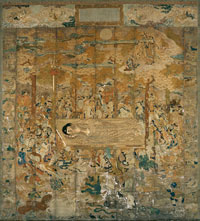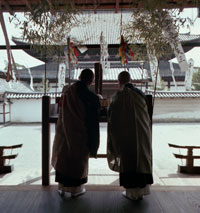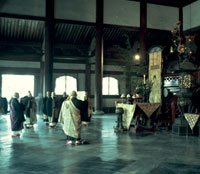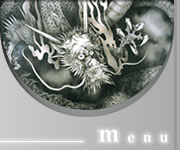Annual Events
New Years Ceremony
修正会 (Shushoe)
(January 1–3)
The New Years celebration in Zen temples starts on the morning of
January 1 and continues until the morning of January 3. The ceremony,
dedicated to world peace, the advance of the Dharma, and the well-being of
the temple, involves a tendoku ritual reading of the 600-fascicle Large Prajña Paramita Sutra on all three mornings (tendoku ritual reading involves
shouting the title and volume number of the sutra, then quickly flipping
through the sutra book itself). When tendoku reading is not possible then
the “Daij¨ Hannya Rishubun” 第十般若理趣分 portion of fascicle 578 is recited in
the ordinary way.
New Years Completion Ceremony
修正滿散会 (Shusho Mansan-e)
(January 3)
This ceremony, marking, as the name implies, the successful completion of
the New Years ceremony, is held immediately following the tendoku reading on
the morning of January 3.
Rinzai Day Observance
臨濟忌 (Rinzai-ki)
(January 10)
Rinzai Day honors the memory of Linji Yixuan (J., Rinzai Gigen), the founder
of the Rinzai school, with a special ceremony expressing gratitude for his
teachings.
Hyakujo Day Observance
百丈忌 (Hyakujo-ki)
(January 17)
This holiday commemorates the Chinese master Baizhang Huaihai (J., Hyakujo
Ekai), honored as one of the principal Zen ancestors for having laid the
foundations of Zen monastic life and architecture, and for having formulated the
first Zen monastic rule.
Ceremonies Marking Special Months of Cultivation
善月祈禱会 (Zengetsu Kito-e)
(January 16, May 16, and September 16)
January, May, and September are months dedicated to the cultivation of good
conduct. Special ceremonies are held on the sixteenth day of these three
months.
Buddha’s Nirvana Ceremony
佛涅槃会 (Butsu Nehan-e)
(February 15)

The Buddha’s Nirvana Ceremony is, along with the Buddha’s Birthday Ceremony
and the Buddha’s Enlightenment Ceremony, one of the year’s Three Buddha
Ceremonies. In this ceremony, commemorating the death and entrance into
Nirvana of Shakyamuni Buddha, a large Nirvana painting is displayed in the
ceremony hall, showing the Buddha lying on his right side in a grove of sal
trees, his head toward the north and his face toward the west. He is
surrounded by weeping gods, humans, and animals. The Nirvana painting shown
here is the property of Tenryu-ji.
“Other Shore” Ceremony
彼岸会 (Higan-e)
(Spring and autumn equinoxes)
The “Other Shore” Ceremony is a memorial service celebrated only in Japan,
where it dates back to the time of Shotoku Taishi 聖徳太子 (574-622), one of the
country's earliest supporters of Buddhism. It is held on the spring and
autumn equinoxes, when the length of the day and the night are equal and
thus symbolize the Buddhist Middle Way, making the equinoxes particularly
suitable as times to commemorate the joy of enlightenment. In the Rinzai
school the occasions are usually celebrated with Segaki ceremonies
(offertory ceremonies to the pretas, with recitation of the Daisegaki
Sutra),
although some regions hold daihannya-e ceremonies (tendoku readings of the
Large Prajña Paramita Sutra) or rituals for a bountiful harvest.
Buddha’s Birthday Observance
佛誕生会 (Butsu Tanjo-e)
(April 8)
This ceremony, also known as Hana-matsuri 花祭り (Flower festival) or the
Kanbutsu-e 灌仏会 (Pouring water on the Buddha ceremony), is one of the Three
Buddha Ceremonies. The Hana-matsuri altar has plaques with the Buddha-Bathing
Verse on either side, a flower-covered shrine in the middle (representing
the Lumbini Garden, where the Buddha was born), and, in front, a basin
filled with sweet tea in which stands a small statue of the newly born
Buddha, with one hand pointing toward the heavens and the other hand
pointing toward the earth. Sweet tea is poured over the top of the statue
using small ladles, a custom based on the legend that when the Buddha was
born the Dragon King appeared in the sky and poured perfume on the infant to
bathe him.
Small Offering to the Pretas
小施食会 (Sho Sejiki-e)
(July or August 1–14)
The Small Offering to the Pretas, also known as Water Offering to the Pretas,
is celebrated every day at 4:00 in the afternoon during the first two weeks
of July or August to make offerings to the myriad spirits of the three
worlds (the world of desire, the world of form, and the world of no-form)
and the ten directions (the four cardinal directions, the four directions
between them, plus above and below).
The Temple Gate Offering to the Pretas
山門施餓鬼会 (Sanmon Segaki-e)
(July or August 15)

The Temple Gate Offering to the Pretas, also known as the Great Offering to
the Pretas 大施餓鬼会, tends in Japan to be equated with the Urabon Ceremony
盂蘭盆会, since it is celebrated on the same day as that ceremony. The two
ceremonies are quite different in origin, however. The Urabon Ceremony has
its source in the
Urabon Sutra Preached by the Buddha 佛説盂蘭盆経, in which Maudgalyayana (J., Mokuren 目連)—one of the Ten Great Disciples of Shakyamuni,
and the one renowned as the greatest in supernatural powers—saw with his
supernatural vision that his mother had been reborn as a preta (hungry
spirit) and wished to save her. He asked the Buddha what could be done, and
the Buddha replied that if oblations were made to the Three Treasures
(Buddha, Dharma, and Sangha) on July 15, the day the rainy-season meditation
retreat ended, the resulting merit would win salvation for his mother and
bring merit to all those who had passed away. Maudgalyayana performed the
designated ritual, the first Urabon ceremony.
The Offering to the Pretas Ceremony (Segaki) is similar in concept to the
Urabon Ceremony, but has it origins in a story about Ananda, the Buddha’s
cousin and attendant. Once Ananda was sitting in samadhi when pretas
appeared before him and told him that he was to die in three days and be
reborn in the realm of the hungry spirits unless he provided limitless
amounts of food and drink to the numberless preta and to a hundred thousand
Brahmans. They added that if oblations were made to the Three Treasures,
then they (the pretas) and others would surely win rebirth in the heavenly
realms. Ananda asked the Buddha how to fulfill these requests, and was
taught the Segaki ceremony.
Other stories also exist, but this one is representative. Unlike the Urabon
Ceremony, no date is fixed for the Segaki, but over the course of time the
two have come to be identified with each other and are now celebrated on the
same day. The influence of East Asian customs of ancestor worship is evident
in both ceremonies.
Bodhidharma Day Observance
達磨忌 (Daruma-ki)
(October 5)
The Bodhidharma Day Observance (also known as the First Patriarch Observance
初祖忌 and Shorin Observance 少林忌) honors the memory of Bodhidharma, the Indian
monk said to have brought the Zen teachings from India to China in the sixth
century. Together with the Founder’s Day Ceremony, it is one of the Two
Ancestor Day Celebrations on the annual calendar.
Buddha’s Enlightenment Ceremony
佛成道会 (Butsu Jodo-e)
(December 8)

Together with the Buddha’s Nirvana Ceremony and the Buddha’s Birthday
Ceremony, the Buddha’s Enlightenment Ceremony is one of the Three Buddha
Ceremonies. The ceremony honors the full enlightenment of Shakyamuni.
According to the traditional Zen histories, Shakyamuni was the
son of King Suddhodana of Kapilavastu, a city in what is now Nepal. He grew
up in sheltered circumstances, married at sixteen and had a son, but at the
age of twenty-nine left the palace to live as a homeless seeker after
awakening to the suffering of worldly existence. He studied under various
meditation teachers without attaining his goal of liberation, and so
turned to the path of extreme asceticism. At the age of thirty-five, years
of ascetic practices had left him too weak to walk and he collapsed by the
side of a river. Restoring his strength with milk received from the milkmaid Sujata, he sat under the Bodhi-tree and vowed to meditate until he had
attained liberation. Finally, on the morning of the eighth day of December,
he saw the morning star and realized full enlightenment. To commemorate this
momentous occasion, Rinzai and Obaku monasteries hold a special meditation
retreat every year, known as Rohatsu ozesshin 臘八大攝心, from December 1 to the
morning of December 8. This period is treated as a single day, with no lying
down permitted for the entire retreat. The Buddha’s Enlightenment Ceremony
is held on the morning of December 8 immediately after the conclusion of
this retreat.
New Years Eve Ceremony
歳晩諷經・除夜の鐘 (Saiban fugin, Joya no kane)
(December 31)
This ceremony, also known as Omisoka 大晦日 in Japanese, is held at midnight on
the last day of the year to express gratitude for the completion of the
year. A purification ritual known as Joya no Kane is performed, in which
sutras are read as the temple bell is struck 108 times, symbolizing the
dispelling of the 108 worldly attachments.
Founder’s Day
開山・祖師毎歳忌 (Kaisan, Soshi Maisai Ki)
(Celebrated on the anniversary of the temple founder’s death)
Founder’s Day, one of the most important ceremonies of the year at all head
temples, honors the memory of the temple’s founding priest and its lineage
of abbots. Together with the Bodhidharma Day Observance, it is one of the
Two Ancestor Day Celebrations on the annual calendar.



